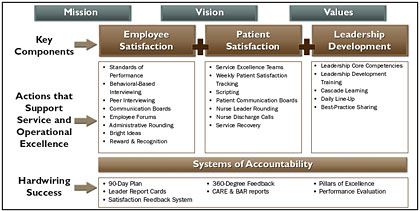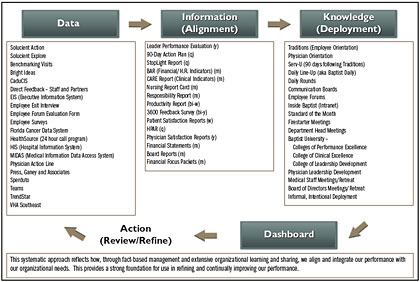Quality Platform – Proceedings from the Quality Colloquium: Baldrige as a Quality Platform
May / June 2005
Quality Platform
Proceedings from the Quality Colloquium: Baldrige as a Quality Platform
Baptist Hospital, Inc. (BHI), in Pensacola, Florida, first entered the formal world of continuous quality improvement with the adoption of continuous quality improvement/total quality management (CQI/TQM) techniques in 1991. After many years of achieving less than expected results, in 1999 we migrated to and adopted the Baldrige Quality Criteria as our quality improvement platform. In 2004, BHI became a recipient of the prestigious Malcolm Baldrige National Quality Award in Healthcare.
We believe that continuous quality improvement (CQI) is a genuine, sustainable strategy for increasing service and market share. Unlike technology and facilities, CQI is not easily achieved. This paper will focus on relatively high-level approaches used by BHI to build quality into products and services. In times of mergers, acquisitions, joint ventures, and declining revenues, we respect organizations that place quality in the forefront of strategic planning. We have found that, ultimately, leadership is what will take an organization to the next level.
More than 30 years of research shows that aligned and integrated organizations outperform their competitors by every measure, execute their strategies more effectively, and deliver better quality products and services. It is this power of alignment that enables world-class healthcare organizations to achieve clinical and operational excellence. These same institutions recognize that clinical excellence results from aligning strategy, processes, people, and patients.
The Baldrige framework is consistent with and supportive of the aims of the Joint Commission on Accreditation of Healthcare Organizations (JCAHO) and the Institute of Medicine’s reports, To Err Is Human: Building a Safer Health System (2000) and Crossing the Quality Chasm: A New Health System for the 21st Century (2001), in creating processes for error reduction and improved outcomes.
The Seven Categories of Healthcare
The Baldrige healthcare platform consists of 7 categories and 19 criteria that, together, form the framework for achieving outstanding results. The 7 categories are:
- Leadership
- Strategic Planning
- Focus on Patients, Other Customers, and Markets
- Measurement, Analysis, and Knowledge Management
- Staff Focus
- Process Management
- Organizational Performance Results
Each category is assigned a point value that is calculated based on the degree of alignment, integration, and deployment demonstrated by the organization. A category is calculated for scoring (achievement of objectives within the criteria) by multiplying a percentage of attainment toward the total possible score in each category. A higher score is based on evidence of an effective, systematic approach, fully responsive to the multiple requirements of the item. Further, the approach is fully deployed; organizational learning, innovation, and analysis are evident; and the approach is fully integrated in response to other criteria.
BHI began the journey to performance excellence in 1995. Our CEO committed to the Board and to the employees that we would begin a new era of transparency and commitment to service and operational excellence. We would create a culture based on open communication, no secrets, no excuses, and focused relentlessly on customer satisfaction. Further, we would become a learning organization with real-time accountability, we would become results-driven, and we would provide leadership development to our 500+ leaders.
BHI’s culture of quality depends on the relationship between our mission, vision, and values (MVV); our Pillars of Operational Excellence; and the use of the Baldrige criteria. All of these are integrated to provide an “engine” to drive our organizational results.
1. Leadership
This category examines how senior leaders address organizational values, directions, and performance expectations. It focuses on how the leaders guide the organization and its governance system. Our organizational leadership relationships shifted from the traditional, vertically integrated model to a set of circular, interconnected relationships that serve to de-silo our governance and delivery system. Our relationships are based on the servant-leader approach, and we depend on a “team-based” culture to achieve breakthrough performance.
All efforts at BHI are driven through the five Pillars of Operational Excellence. This forces a balanced approach across each pillar. These pillars are the “vital signs” of our organization, and results must be achieved in each pillar to sustain a culture of organizational excellence. Our migration to the Baldrige criteria was supported, in large part, by the similarities between our pillars and the seven categories.
Our leadership focus on service and operational excellence (Figure 1) links the key components that support our mission, vision, and values: employee satisfaction, patient satisfaction, and leadership development. It also demonstrates the actions used under each component to sustain our efforts and shows how our organization “hard wires” these actions into daily behaviors.

2. Strategic Planning
This category examines how an organization establishes its strategic objectives, including how it enhances its competitive position, overall performance, and future successes. It goes further to examine how an organization converts its strategic objectives into action plans and how it assesses progress relative to these action plans. BHI’s strategic planning process begins with our mission, vision, and values and is filtered/screened through our five Pillars of Operational Excellence. This assures that our organization starts at the right place and ends up at the right place.
3. Focus on Patients, Other Customers, and Markets
The third category addresses how organizations determine requirements, expectations, and preferences of patients, other customers, and markets. BHI has developed and implemented a robust listening and learning system to differentiate and stratify our customers and their attendant needs.
4. Measurement, Analysis,
and Knowledge Management
The fourth category addresses analysis and management of data, information, and knowledge assets. BHI believes that healthcare is data-rich but often knowledge-poor. Figure 2 summarizes our systematic approach to turning data into information, information into knowledge, and knowledge into actionable reports. Information creates alignment, and actionable knowledge supports deployment.

5. Staff Focus
The fifth category addresses key human resource practices. BHI uses a team-based culture to achieve results under each of our five Pillars of Operational Excellence. Empowerment is developed by linking authority with each individual’s responsibility to provide world-class service to each customer. We have developed interdisciplinary teams that function to support each pillar with the sole purpose of enhancing the staff.
6. Process Management
The sixth category examines how an organization identifies and manages key processes for delivering healthcare services to patients. BHI developed a six-step service design process to guide the organization in product development from conception to implementation and evaluation of all new products and services. We use an evidence-based clinical process improvement model to bring new or modified clinical pathways and procedures on line. This assures that all new policies and procedures meet the needs of all customers and build value into the process.
7. Organizational Performance Results
The seventh category provides evidence of an organization’s performance and continuous improvement in each of the previous six categories. It is the most heavily weighted category (450 points out of the possible 1,000). This weighting supports the Baldrige proposition that a high-quality organization must produce high-quality results. In this category, BHI has achieved the highest employee morale/satisfaction in the healthcare sector and across industries. We continue to have low turnover in our company. We lead the nation in Press Ganey Associates patient satisfaction survey.
Clinically, we have achieved a reduction in pressure ulcers from 9.0% to 1.7% of adjusted daily census since 1999. In collaboration with the Institute for Healthcare Improvement (IHI), we have reduced ventilator-associated pneumonia, reduced blood and urinary tract infections, improved outcomes, and reduced cost per case in our critical care units. BHI’s hospitalist program has achieved dramatic breakthroughs in reducing cost per case, while outperforming peer physicians in every measurable criteria (mortality, morbidity, complications, readmissions rates, patient satisfaction, and referring physician satisfaction). Financially, BHI has continuously reduced net days in accounts receivable and has increased net patient revenue since 1999, even during extreme downturns in the market. Lastly, we have increased market share in a very competitive environment.
* * *
In summary, it has been BHI’s experience that to create a high-performing, high-quality organization, one must:
- Make patient-defined quality and value the strategy.
- Convey the vision.
- Measure performance, consistently, at the whole-system level.
- Assure cooperation across the continuum of care.
Bob Harriman is currently vice president for Clinical Services, Quality Improvement and Patient Safety for Baptist Hospital, Inc., and a consultant for the Baptist Healthcare Leadership Institute in Pensacola, Florida. In more than 35 years in healthcare, he has managed large diagnostic imaging practices, a 165 physician multi-specialty group, for-profit ambulatory surgery centers, physician-hospital joint ventures, a complete range of outpatient services, and a full-service ambulatory care facility. Harriman holds degrees in psychology and education and received his doctorate degree from Florida State University. He is also a radiologic technologist and a member of the Malcolm Baldrige Board of Examiners.
As senior vice president of medical affairs for Baptist Healthcare in Pensacola, Florida, Craig Miller is responsible for the clinical quality program, physician relations and recruitment, and the physician leadership program. Miller received his bachelor’s degree from Manchester College in North Manchester, Indiana. His medical degree is from Indiana University. He received a National Institute of Health post-graduate fellowship from the National Heart and Lung Institute and completed a residency in internal medicine at Indiana University Hospitals, followed by a pulmonary fellowship at Southwestern Medical School at Parkland in Dallas, Texas. His career has included being assistant professor of medicine at Indiana University School of Medicine, followed by clinical appointments to Indiana University and the University of Florida.
